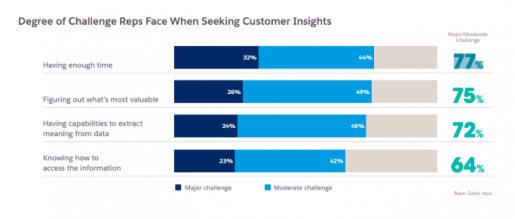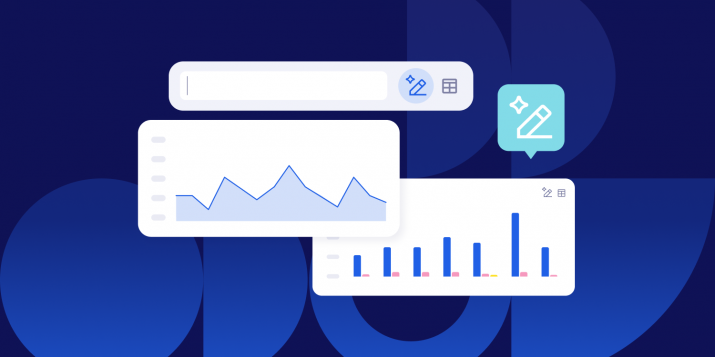
Why sales needs social media engagement insight
It’s time to face it! We are in Q4 and moving into 2021, so the stakes are high for sales, meaning it’s probably time to look for the next lever to optimize selling capabilities.
COVID-19 has made it clear that sales strategies need to evolve. As a result, 79% of sales reps say they’ve had to take on new responsibilities and metrics and quickly adapt to new ways of selling. However, many sales reps feel that expectations from leadership haven’t been linked to their new reality.
New Salesforce data has revealed the top sales challenges for 2021. For sales leaders it’s crucial to understand the top challenges blocking the sales team from booking meetings, driving revenue, and hitting quota. Knowing the obstacles will help sales leaders plan in advance and find solutions to resolve the top challenges that their sales teams will be facing in 2021.

One of the biggest challenges sales reps have always faced and will continue to face is a lack of insight into their business prospects, which affects their outreach process.
When seeking insights, a shocking 75% of sales reps struggle to figure out what is valuable to work on, in other words, which leads/business prospects to prioritize. 72% of reps struggle to find capabilities to extract meaning from all of the data in front of them, and 64% struggle with knowing how to access the right information. So, what can be done to help the sales teams?
The new buying process
It’s fantastic when marketing gets a good number of leads and passes them over to sales to ultimately convert them into Sales-Qualified Opportunities and finally close a sale. However, not all leads marketing hands over should have been handed over.
If this doesn’t sound familiar, I promise this will make more sense as we talk more about the importance of having good-quality leads when it comes to the sales process and knowing what leads to prioritize.
No one likes spending needless amounts of time figuring out how to get things done or executing pointless and tedious tasks when there could be easier ways of doing things, in turn, getting the needed results. This is particularly so for sales teams.
Let’s be honest: Sales teams don’t want to receive leads from marketing that are not the right fit, have wrong or no contact information, or provide zero to no insight into the business prospects’ interests or engagement activity. Every salesperson knows that the less data on a lead they receive, the more time they have to look it up.
No one can guarantee that all leads will have the correct phone numbers or email addresses, and it is sometimes part of a sales rep’s role to find this information. But surely there is more information sales reps can get to help them when they reach out to their prospects?
The need for information
Marketers, whose work sales teams should value more, want to pass over as many leads to sales as possible. Many marketers focus on building effective lead-scoring models, but just because a lead score up doesn’t mean it is ready to be passed over to sales.
Digital transformation has caused a fundamental change in the way buyers research and make purchases. Today’s buyers want to engage with sales much later than they ever did and want to have as much information as possible before jumping on a call with a salesperson.
Buyers can do this because of the abundance of information they are able to gather and absorb. This, in turn, has created a new buying process. This new buying process means that sales and marketing need to be aligned and help one another get as much information as possible on their business prospects and their buyer’s journeys as possible.
Sales and marketing need to unite to determine their ideal customers and then get them to talk to sales as fast as possible. But how can marketers reach some of their goals and help sales do their job better at the same time? Easy: Get as much engagement insight as possible.
Recommended for further reading
Sales and marketing are one
When sales feel like they have been given leads with very little insight to work with, they will stop relying on marketing for lead generation. This leads to sales teams doing much of their own prospecting and not working the leads marketing worked so hard to get on time or properly (if at all).
In this new buying process world, where buyers don’t want to engage with sales until much later in the buyer’s journey, it can be a really bad idea to have expensive salespeople cold-call and waste time qualifying leads that turn out to be the wrong fit.
Another problem stems from this is that it’s not predictable. Sales and marketing need to be aligned in order to truly predict future revenue. Either that or you fundamentally have a broken forecasting process—and nobody wants that.

Businesses with proper alignment see a 32% increase in revenue growth, while organizations with less alignment see a 7% decrease. Organizational alignment between sales and marketing teams is particularly important, as these two departments are closely connected throughout the purchasing process. However, aligning sales and marketing and achieving this level of cohesion presents many obstacles for companies. After all, sales and marketing have always been kept in separate containers. They still remain apart in many organizations.
Here are some of the most important sales and marketing alignment statistics you should know:
- 50% of sales time is wasted on poor prospects SalesHub
- 35-50% of sales go to businesses that respond first HubSpot
- Tightly aligned’ companies achieve 24% faster three-year revenue growth and 27% faster three-year profit growth HubSpot
- Only 12% of B2B buyers want to meet in person with a sales rep, and 71% start their process with an unbranded search (Source)
- Sales and marketing alignment can help businesses become 67% better at closing deals. Marketo and Reachforce Research
As a sales professional and working closely with inbound sales teams, I’ve learned so much in the past 11 years, especially how important it is to ensure that both sales and marketing teams work together to help ensure a high volume of quality leads are moved down the sales funnel faster.
Both teams need to hit their KPIs and show their value. A disconnect between them can shape management’s perception of both teams and their value—definitely not in a favorable way.

Build a great lead-scoring system with valuable insights
Sales leaders, alongside marketing leaders, need to focus on the three V’s when it comes to lead generation: Volume, Value, and Velocity.
Velocity is especially important when it comes to answering the question: How fast can I flow something from the top of the funnel to the bottom of the funnel and impact the bottom line of the business?
Marketing is there to help get salespeople in the room with potential buyers and reach the goal of building a successful lead-generating Inbound Program to generate high-volume and high-quality leads (consisting of sales opportunities that are more likely to close).
All this depends on having as much insight on the leads as possible.
The marketing department ensures that only legitimate and accepted leads are loaded in the lead tracking system. Generating a good volume of leads is not the issue for many organizations.
Many organizations have been tripling their sales teams due to strong marketing functions that harness real-time data streams and first-party customer insights. The challenge arises when no one knows where the leads actually came from, what their core interests are, and how much they have been engaging with the brand.
What leads should sales get?
We all know that qualified leads come from a quality audience, and marketing teams work hard to use professional demographic data to target the right people by job title, company, industry, seniority, and more.
Some lead-scoring models are based on:
- Demographic information
- Company information
- Online behaviour
- Spam detection
- Email Engagement
- Social engagement
Okay, let’s say marketing generates 400 leads a month overall—which is fantastic! But how does the marketing team know which leads are worth passing on to sales? Sure, sales and marketing can use a basic lead scoring model to score them and narrow down the leads that are deemed sales-ready.
Let’s say marketing passes 100 leads to sales from the 400 leads they managed to obtain. The 100 leads scored up and seem sales-ready. How do you know? Where did the leads come from? What insights do you have? What content have they been engaging with, where, and when? What are their core interests? And how many times have they engaged with the brand and even the sales reps?
Why is the buyer’s journey important?
Knowing what leads are at what stage of the buyer’s journey is crucial, in order to help sales close opportunities faster. In order to do this, the marketing team will need to optimize their lead scoring, nurturing, segmenting, and attribution models.
However, this should not just be the job of the marketer alone to determine what helps leads score up faster and offer more value. Sales should be involved and offer insight into common challenges they face and should be part of the decision-making process when it comes to finding ways or tools to help obtain their Ideal Client Profiles (ICP).
You can score your leads based on multiple attributes, including the professional information they’ve submitted and how they’ve engaged with the brand’s website and across the internet. This process helps sales and marketing teams prioritize leads, respond to them appropriately, and increase the rate at which those leads become customers.
You might even consider more than one lead score system; meaning you might consider expanding your product lines, new regions, and even new personas. Looking at the right fit (is the prospect in the right region, right industry, and how much have they engaged with your online content? alongside the interest.
And if you’re a software company that sells different types of software via different sales teams, and have different types of buyers, you could create two different lead scores — one for a buyer’s fit and the other for their interest in each tool.
Truth be known you could build any kind of lead scoring model you wanted to but if you cannot track the business prospects buyer’s journey in full and have that data be automatically appended into your CRM (for marketers marketing automation) then you are missing something that will help your sales reps win more deals.
Why do sales reps need social engagement insight to win?
Social media is the third-largest engagement channel, just after email and websites. When it comes to the B2B buying journey, more than 50% of B2B buyers now turn to networks such as Facebook, Twitter, LinkedIn, and even Instagram to get peer reviews and information that can help them make key strategic purchasing decisions.
Our Managing Director, EMEA, and APAC at Oktopost, Colin Day said it best: “the B2B buyer’s journey has changed and customers have started to adopt a level of self-sufficiency and proactiveness that no longer aligns with what we would class as a ‘conventional sales model’.”
Over half of your target buyers are active on social networks. Tracking how engaged a lead is with your brand or your sales team on social networks gives you and your sales reps a pretty good idea of how interested they are.
Being able to track and see how many times they clicked through on your company’s tweets and Facebook posts or how many times they retweeted or shared those posts is key.
Even better is being able to see if they commented and what they said can help your sales reps personalize their outreach and tweak their overall talk tracks. It will help them stand out and also help them know where they should mostly engage with them: LinkedIn, Twitter, Facebook, etc.

Think about it – the more insight your sales reps see on their business prospects, the faster they can determine which leads to prioritize, save time by accessing the right information, do better personalization, and be able to extract the meaning from all the data in front of them.
Use insight to prioritize leads
The following are a few key aspects that sales reps need to consider when working with leads effectively:
- What leads to prioritize (who and when)
- What has a lead been engaging with and how often (webinar, whitepaper, social content)
- How to engage with a lead (personalization and channel)
Especially for sales development leads, and account prioritization drives efficiency.
SDRs must focus their efforts on the right prospects at the right times. Calling up leads that just score up could be wasting a huge amount of time. Not to mention, this leaves too much room for error. A good lead might be overlooked during the lead scoring process as the insight into the buyer’s journey is missing, leaving the leads not to be noticed or actioned in time.
Relying just on data tracking email clicks and opens, whitepaper downloads or webinars registered to is just a small portion of the buyer’s journey. Why not allow your sales reps to discover and follow up on people who recently engaged with content on social media as well, gain their contact information (email, phone number, company, location, etc.), and allow your reps to engage with them?
As the saying goes, “People trust people and buy from people they like”. Having the right insight and tools will help your sales reps be the right people for your buyers.


